Home \ Community Development Projects \ Comprehensive Community Development Project in Butuo
The community based comprehensive development project for nutrition and health of children in rural areas of Tuojue Town, Butuo County, Liangshan Yi Autonomous Prefecture, Sichuan Province was funded by Shanghai United Foundation and New Zealand Embassy. The project lasts for 1 year.
• Project introduction
The project piloted a community based comprehensive capacity development project targeting nutrition and health of children in impoverished rural areas and aiming to improve children’s growing condition and environment. The project established ‘Village Action Groups (VAG)’ in the community, and improved community facilities and living environment of children in rural areas through capacity building initiatives for the villagers. Meanwhile, the project experiences are to be summarized to facilitate project promotion and to act as a reference for development of government policy and criteria and allocation of resources.
• Project objectives:
The overall objective is to implement a pilot community-based comprehensive development project for children.
• Specific objectives:
- 80 households’ knowledge of nutrition is improved to 80%.
- 80 households’ knowledge of hygiene is improved to 80%.
- Establish 3 villager action groups
- Implement 3 villager action initiatives to improve environment of the local community.
- 40 households implement family vegetable garden activities to improve children’s nutrition.
- 40 households improve children’s nutrition through breeding activities
- 100 children’s nutrition is improved.
- Condition of toilets in three schools is improved.
- Improve or establish 3 school hand washing facilities.
- 5 local government officials know about project objectives and activities
• Project objectives and outcomes
- Village Action Group
The VAG took the main role for project implementation. The villagers were mobilized to voluntarily participate and established 3 village action groups. 120 households in total participated in the activities. There were 25-30 members and 2 group leaders for each group.
The establishment of VAG helped the villagers to learn about organization, participation and project management. In the future they would grasp self management knowledge. The project provided baby chicks to villagers as well as training on breeding chicks, which helped them to reduce poverty. The villagers’ comprehensive capacity was improved which was good for improvement of children’s nutritional and hygienic level. The villagers would also influence those who did not participate in the project and disseminate knowledge on nutrition and hygiene to them. 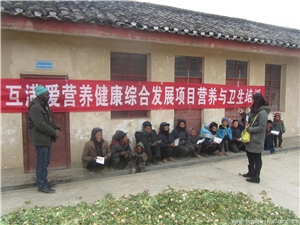 Training of villagers.
Training of villagers.
- Survey on local children’s conditions
100 children were surveyed. Based on the results, project solutions were developed including providing training to villagers on children development, nutrition and health knowledge, improving drinking water and toilet facilities, helping villagers to implement planting and breeding activities, providing villagers with opportunities of increasing income while providing good nutritional supplement to the children. On one hand, it helped villagers to increase their knowledge, on the other hand, it was supportive to them for educating their children, which provided solid foundation for breaking the cycle of poverty. 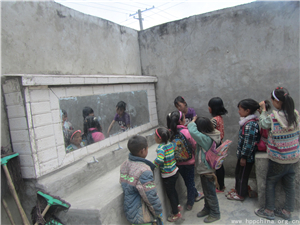 Children using basins built by the project.
Children using basins built by the project.
- Village clean-up campaign
720 villagers participated in building toilets and basins for primary schools in 3 villages. Village cleaning actions not only helped to clean the village environment, but also were helpful for enhancing villagers’ cohesion and their capacity of cooperation with one another.
Establishing elementary hygienic facility was helpful for improving the overall education level of primary school. When the children had the habit of going to the toilet and washing hands before eating and after toilet, their parents could be influenced and consequently develop good hygienic habit (from the baseline survey, 54% of the households defecated in the field or brushwood, 35% of the households used toilets, 6% of the households had hygienic toilets and 5% of them used public toilets). 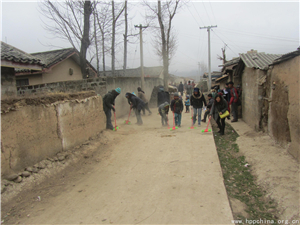 Villagers cleaning up the villages.
Villagers cleaning up the villages.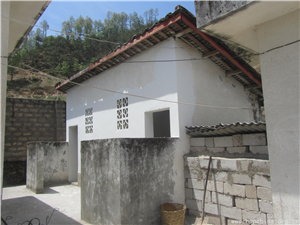 The hygienic toilets being built.
The hygienic toilets being built.
- Breeding egg chicken and building family vegetable garden to improve children’s nutrition.
720 villagers received baby chicks and training about breeding the chickens. Breeding egg laying hens is a way of improving nutrition and health condition of the household as well as increasing income. Improvement of nutrition and health condition was helpful for his/her growth and study. It also helped him/her to continue to receive education, which provided more opportunities for him/her to lead the family to get rid of poverty in the future. 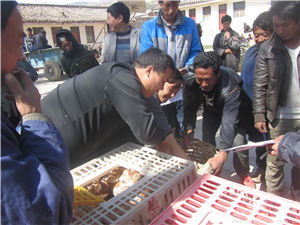 Distributing baby egg chicks.
Distributing baby egg chicks.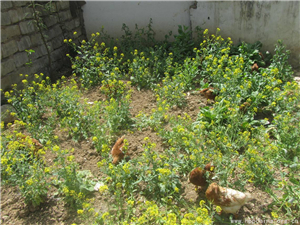 Breeding egg laying hens in villagers’ own vegetable gardens.
Breeding egg laying hens in villagers’ own vegetable gardens.
• Dr. Yang Zhenbo, UNICEF water and environmental health specialist visiting the project
HPP PMO invited Dr. Yang Zhenbo to provide on site guidance. Dr. Yang Zhenbo visited the school and participating households, discussed with Bureau of Education, Maternal and Child Health care Hospital, Women’s Federation, Bureau of Health, Center of Disease Prevention and Control about breeding environment, hygiene and quality of water. He also trained villagers to pay attention to the environment and emphasized the necessity of using toilets. Open defecation brings diseases to children and adults alike. Washing hands before eating and using soap could reduce the risk of bacteria entering into the body. In addition, he discussed with the project staff about the needs of rebuilding toilets and the types of hand washing basins etc.  Dr. Yang discussing and studying with 5 government facilities.
Dr. Yang discussing and studying with 5 government facilities. 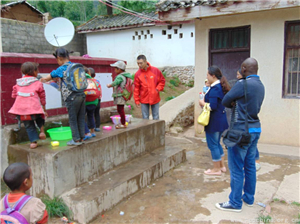 Dr. Yang looking at basins built by the project.
Dr. Yang looking at basins built by the project.
 CD Butuo project is supported by Shanghai United Foundation and New Zealand Embassy
CD Butuo project is supported by Shanghai United Foundation and New Zealand Embassy